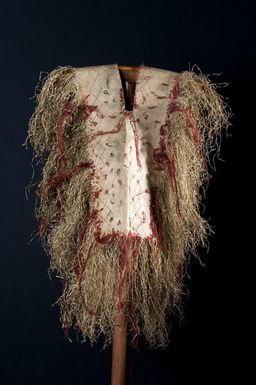Connect with National Museum of World Cultures Foundation
Contact this content partner to get more information about this item.
Shoulder dress of plaited pandan fibres decorated with red woollen thread
- Description:
- This poncho is braided from pandanus leaf and decorated with wool. Samoa is known for its refined weaving techniques with pandanus leaf. Before we can start weaving, the material has to be prepared. First, the serrated edges and central rib of the pandanus leaf are removed. The matted underside of the leaf is pulled off over a length of approximately 4 cm and the leaves are left to dry in the sun. They are then rolled up into bundles. The rolled bundles are wrapped in green leaves and heated in an oven for half an hour. The heating makes it easier to remove the shiny top layer. Next the leaves are tied in a braid and hung in the sea to bleach for two weeks. Finally, the leaves are laid out to dry in the sun, the underside is scraped to remove unnecessary fibers, and they are split into narrower strips that will be used for weaving. \In the 18th and 19th centuries, woven mats were often decorated with very valuable red feathers from a local species of bird (Coriphilus fringillaceus) or from a bird from Fiji (Lorius solitarius). Red feathers were part of the trade items that people from Samoa traded with people from Fiji. From the arrival of Europeans in the 18th century, feathers were increasingly replaced by red wool that was readily available. \The poncho form was introduced from Tahiti where high-ranking people wore a tree bark cloth in the shape of a tiputa, a kind of poncho. In Polynesia, it was only on Tahiti and the Cook Islands that clothing covering the entire body was worn. This appealed to the English missionaries who encouraged all converts to wear this type of tree bark cloth. When the catechists of Tahiti went to Samoa to preach the faith, a tiputa was seen as a sign that the wearer was a good Christian.
- Format:
- image
- Collections:
- National Museum of World Cultures Foundation
- Content partner:
- National Museum of World Cultures Foundation
- Availability:
- Not specified
-
Copyright status: All rights reservedFind out more about what you are able to do with this itemThis item is all rights reserved, with means you'll have to get permission from National Museum of World Cultures Foundation before using it. For more information, please see our use and reuse page.More informationNational Museum of World Cultures Foundation has this to say about the rights status of this item:
http://rightsstatements.org/vocab/InC/1.0/
What can I do with this item?Non-infringing useNZ copyright law does not prevent every use of a copyright work, and this item may be hosted by an international institute or organisation. You should consider what you can and cannot do with a copyright work.No sharingYou may not copy and/or share this item with others without further permission. This includes posting it on your blog, using it in a presentation, or any other public use.No modifyingYou are not allowed to adapt or remix this item into any other works.No commercial useYou may not use this item commercially.
Related items
Welcome and warm Pasifik greetings
The information on this site has been gathered from our content partners.
The names, terms, and labels that we present on the site may contain images or voices of deceased persons and may also reflect the bias, norms, and perspective of the period of time in which they were created. We accept that these may not be appropriate today.
If you have any concerns or questions about an item, please contact us.
